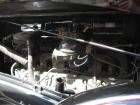|
Re: 1940 Custom Low Compression
|
||||
|---|---|---|---|---|
|
Forum Ambassador
|
Did you do rings as well or were the rings wet with oil the first time you checked? Exactly the same test conditions on both attempts ie all plugs were out both times so the engine was able to spin at no load or at same speed?
Posted on: 2014/5/27 15:38
|
|||
|
Howard
|
||||
|
||||
|
Re: 1940 Custom Low Compression
|
||||
|---|---|---|---|---|
|
Home away from home

|
My oil pressure gauge usually starts out low and works its way up to 40. If I rev it, the pressure will go above that, but s soon as it warms it stabilizes at 40. I use 30 weight oil.
I'm assuming all the hydraulic lifters were removed and cleaned, with cylinders and plungers kept together. There were issues with !940 356 engines not getting sufficient oil to the lifters, so some modifications on the lines from the oil filter were advised. See post#30 packardinfo.com/xoops/html/modules/newbb ... lat&order=ASC&type=&mode=0&start=20 I subsequently found my oil filter was plumbed backwards. Look for the IN and OUT stamping on the filter. I think I used a mirror so it was probably on the bottom.
Posted on: 2014/5/27 15:39
|
|||
|
||||
|
Re: 1940 Custom Low Compression
|
||||
|---|---|---|---|---|
|
Home away from home
|
When did valve job all rings and walls looked fine, not even much of a ridge at top. Did only one valve at a time so could not get mixed up. Did all compression checks hot and cold. All plugs out, carburetor full open. Actually the cold reading the same amount of compression. Should there be a difference between hot and cold? Maybe try a third compression gauge.
I will check, but after twenty years and thirteen thousand miles the oil canister must be correct. The bottom of the canister gets fed from where the oil sender gets its pressure and the top of the canister dumps a little higher up the side of the block. Perhaps will try running without new filter, and take off both oil canister lines, to make sure nothing got clogged.
Posted on: 2014/5/27 16:20
|
|||
|
||||
|
Re: 1940 Custom Low Compression
|
||||
|---|---|---|---|---|
|
Forum Ambassador
|
I doubt the filter has anything to do with it. The lifters would be noisy if there was a problem with oil flow.
I was wondering if the loss was due to rings rather than valves. If there was a nice oil layer and rings were wet and sealing nicely at the first test and comparatively dry the second, then some loss thru the bottom would be expected.
Posted on: 2014/5/27 17:06
|
|||
|
Howard
|
||||
|
||||
|
Re: 1940 Custom Low Compression
|
||||
|---|---|---|---|---|
|
Home away from home
|
Remember the lifters have become noisy. Might be rings, don't notice any pressure at oil filler neck, or at relief pipe along side and bottom of engine.
Posted on: 2014/5/27 19:56
|
|||
|
||||
|
Re: 1940 Custom Low Compression
|
||||
|---|---|---|---|---|
|
Forum Ambassador
|
My bad. I didn't catch the statement on noisy lifters. If the filter is plumbed inline so all goes thru the filter before going into the lifter galley port then that could be an issue causing the lifter noise. Packard did make several changes with filter types and finally changed the plumbing route to feed the lifter port directly because of noise.
As you said, after all these years It is strange the plumbing should suddenly appear a problem. If it is inline, unless a filter is completely different or something got into the line and blocked flow it should still work as before. Another question -- When you did the valves did you use the gauge and grind off the stems for the changed clearance? I wonder if the valves could be not seating fully -- but again, strange it would take 200 miles to show.
Posted on: 2014/5/27 20:24
|
|||
|
Howard
|
||||
|
||||
|
Re: 1940 Custom Low Compression
|
||||
|---|---|---|---|---|
|
Home away from home
|
Not sure but plumbing should be correct. A couple times back was at Custom Auto, for some engine work and believe Cal would have caught that. But will try to clean things out anyway. Did not check the lifter stem clearance, as they were not changed. Took each one out one at a time, took apart with the twist, cleaned, put back together and put back in. So I did not see a reason to check stem clearance. But, if I take off the head again will do just to make sure. Maybe need to bite the bullet and purchase new lifters. Max Merritt sells the originals at a premium. How are the imported ones from Kanter?
Posted on: 2014/5/27 20:44
|
|||
|
||||
|
Re: 1940 Custom Low Compression
|
||||
|---|---|---|---|---|
|
Forum Ambassador

|
My best guess as to the compression loss would be failure to check and adjust (if needed) the hydraulic lifter take-up clearance - even more important if the valves were refaced in addition to the seats being resurfaced. If the last person to do a valve job also failed to check the clearance, the cumulative effect of 2 seat/valve refacings could have used up most or all the clearance. Checking the take-up clearance is simple, only a minute or two per valve, and is very important to longevity of the job.
Posted on: 2014/5/28 8:03
|
|||
|
||||
|
Re: 1940 Custom Low Compression
|
||||
|---|---|---|---|---|
|
Home away from home
|
I did the job, just did a light hand lapping, so did not think it would make enough difference. But you are the third person to mention the same thing. So now I need to locate the setting tool, told it is a very simple tool. Saw a picture of one, looks like I could make one on my lathe, but if anyone sells them let me know.
Posted on: 2014/5/28 8:11
|
|||
|
||||








